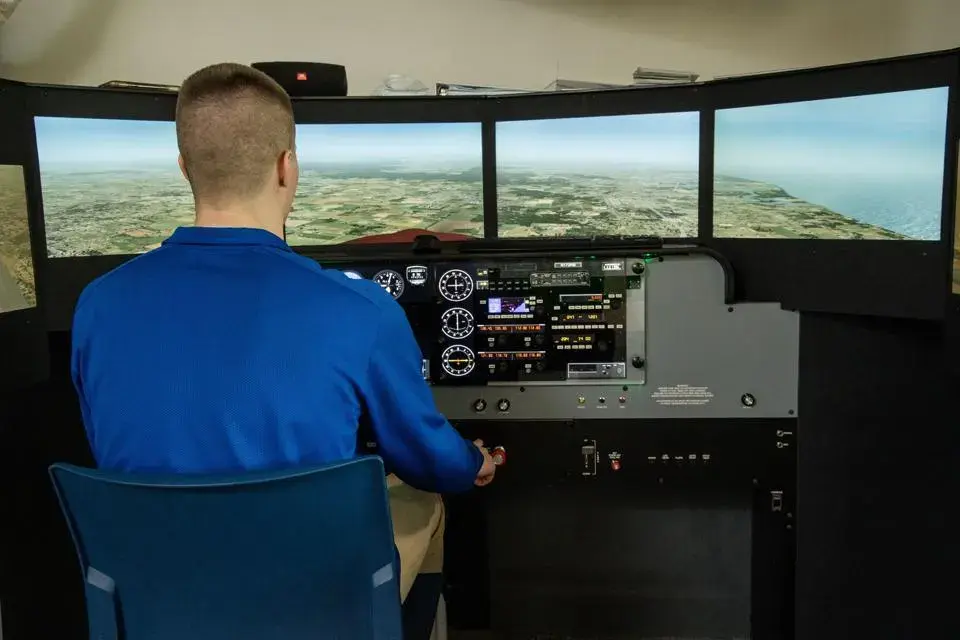Located innocuously on the edge of Gerald R Ford International Airport, the West Michigan Aviation Academy is a remarkable example of how good a charter school can be. Now in its 13th year, the school has grown to 620 students from grades 9 to 12.
The first thing you notice stepping from the main office into the multi-use room are two biplanes suspended from the ceiling, surrounded by flags. The flags represent the countries their students have come from—a number approaching 50.
We visited the WMAA on a Friday afternoon. We assumed at first that the school day had ended and the students had gone home because the chaos one typically sees in a high school around the main office was missing.
But as we walked around the building, we saw class after class of engaged students working on various assignments—all overwhelmingly caught up in their studies. In some classes, this meant using flight simulators, in others discussing the day’s reading, and in others walking around bench tables working together on projects.
Students seemed pleased to have visitors and were only too willing to talk about the Academy. They looked us in the eye, introduced themselves, and welcomed us. This made it easy to ask them questions about their experience.
We entered the senior flight class, with 27 students working on their flight certification. The first young man we spoke with said he planned to fly corporate clients. Next, a young woman said that her goal was to become a missionary pilot. A second young man said that his genuine interest was aerospace engineering, especially rockets, but that he loves to fly, wants to get his pilot’s license, and plans to keep flying whatever his ultimate career.
The aviation theme is deeply ingrained in the school, and with many teachers having military aviation backgrounds, many of the customs and traditions have carried forward. Students in the flight school have call signs, good-natured nicknames, as one student explained, designed to keep them humble. There is a stairwell where specific accomplishments, such as first flights, are recorded on the walls. A wall of honor commemorates the 85 staff and students who have served in the US military. Presently, about 10% of graduating students will enter military service.
But the school is not only for flyers. The very first student we spoke with, a gregarious 10th grader, when asked if she was on the pilot track or the engineering track, said neither. She just loved the school for the culture of hard work and respect. She added that she planned to become an educator. When asked if she would want to teach at the Aviation Academy, she said, “Absolutely. In a heartbeat.”
Any school that can develop this degree of emotional attachment among its students is doing something right. As with all charter schools, there is no one at the Aviation Academy just because its location is convenient; these are students with a strong sense of shared purpose who want to be there. Many drive an hour or more each way to and from the school. We heard of one young woman who had moved 4 hours to the north but who flew back and forth periodically so that she could finish her air certification and graduate with her classmates.
What stands out most about WMAA is not any particular piece of technology nor the specifics of the curriculum but the way the school has cultivated engagement among its students. The head of the school, Nicole Gasper, described the school as being “old school values meets innovative education.” The school encourages hard work but values all student outcomes, not limiting success to college admissions statistics. “There are many opportunities for graduates besides college,” Gasper said.
Part of the drive for relevance has been to lean heavily into career and technical education so that while students are learning core science and engineering content, they are doing so in the context of readily available applications, with employment opportunities, and with the ability to test things out hand on, whether through vex robotics or by flying drones in the gym.
Or by building planes. Next to the flight school was another class building a small plane from a kit. When finished, after it has been put through its paces and established its airworthiness, it will be auctioned off to raise money for the school and to purchase the next few kits.
Seeing an extraordinary school achieving exceptional results with its students, we were presented with one big question: Why hasn’t this been replicated?
There are hundreds of US cities with suitable airfields and interested populations. And while there are certainly capital costs, the human spirit and not the physical capital drove the learning. While replicating the school exactly, with flight simulators, etc., would probably require a foundation similar to the one that has supported the school, these things are not the essence of the school. A school with less money might need to lean more into the engineering aspects of the school, with more time spent building planes and less time spent learning to fly, but with pilots in such demand, money should not be the limiting factor.
There are other schools providing students with aviation education. The Aviation Career and Technical High School in NYC has been training airplane mechanics since the 1930s, and the Raisbeck Aviation High School, a magnet school located near King County International Airport, has been in operation since 2004. Both of these schools have exemplary performance.
Nor should flying be the only avenue where such schools can thrive. Any thematic focus, with suitably motivated individuals who can inspire students and build within the school a culture of hard work and respect, the “old school values” that Gasper prided herself on, should be able to find success.
Ultimately, what matters is the clear articulation of a vision. The more focused a school is, the more clearly it can articulate its reason for being, the more likely it is that the school will be able to deliver something uniquely good. This vision needs to start with the leadership, be reflected among the staff, and be embodied in the students' experience.
Dick DeVos, whose commitment to education and personal love of flying led to the school’s creation, amplified this sentiment. “Our mission was to deliver an engaging environment where students could lean into their passions and develop in-demand skills that help lead them to successful careers and fulfilling lives. The success of our students inside and outside of the classroom demonstrates that WMAA’s bold and innovative model works, and we hope it inspires similar approaches across educational landscapes.”
WMAA is a prime example of what is possible and how it can be accomplished. Others would do well to emulate them.

